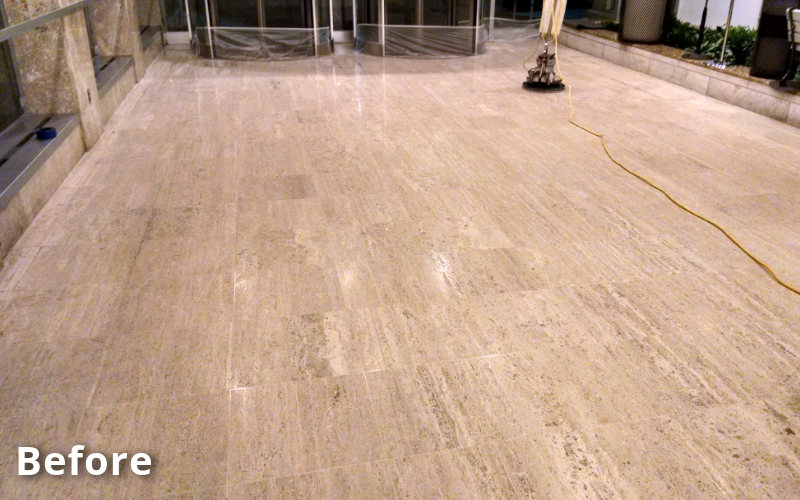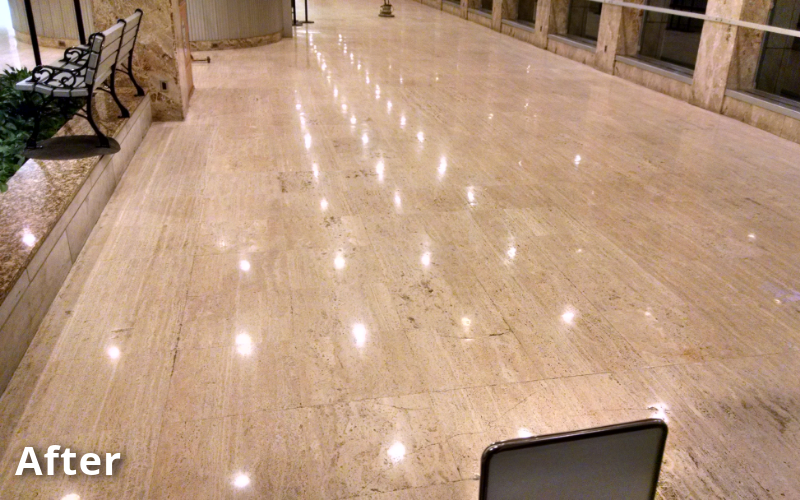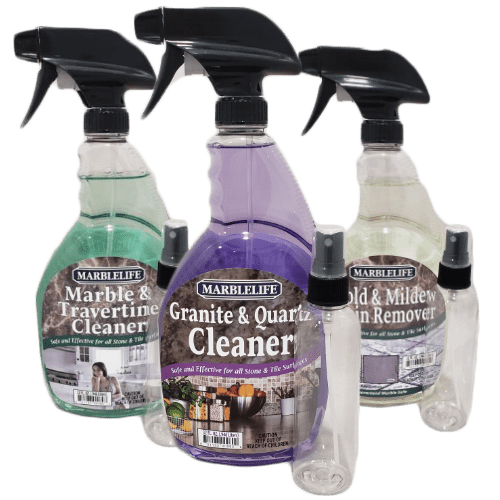- Home
- Marble
- Concrete
- Tile & Grout
- Tile And Grout cleaning
- Tile And Grout Maintenance
- Tile And Grout Sealing
- Commercial Tile And Grout Care
- Residential Tile And Grout Care
- Colorseal
- Mold Blocking Treatments
- Medical Tile And Grout Care
- AntiGraffiti Treatment
- TileLok™ - High Durability Coating
- Grout Stripping
- Mexican Tile Terra Cotta
- Still Using Wax?
- Granite
- Galleries
- Other
- Terrazzo
- Travertine
- Vinyl
- Natural Stone
- Slate
- Corian Countertops
- Homeowner University
- Stone Care Blog
- Commercial Markets
- MARBLELIFE® Products
Residential Sealing Services
Sealers are applied to enhance stain resistance by filling in pores in the stone. Sealers can be either penetrating or topical.
Penetrating sealers such as MARBLELIFE® Stone Sealers are designed to soak into the pores. Topical sealers, on the other hand, are designed to seal and to modify the finish or color of the surface.
ABOUT MARBLE SEALING
Countertops encounter more potentially staining liquids than almost any other surface (cooking grease being the most common). Unresinated countertops are especially susceptible to spill absorption and staining.
Resination is the process of reducing stone brittleness by filling capillaries and pores in the stone with a polyester resin. Unfortunately, this is not an easily identifiable feature, and the counter does not often provide indications of resination. The cost of sealing is substantially lower than the cost of replacing the counter if stained. Stone should be sealed every other year.
WHY MARBLELIFE?
- We provide you with the most efficient and trained staff in all the new processes out there, by training our staff in our state-of-the-art R&D Facility in Sanford Florida so that we can bring expert restoration to your doorstep.
- We can handle any situation that you need. Don't believe us? Just check out our trusted clients such as, Rockefeller Center, J. Paul Getty Museum, Ford World Headquarters, Grand Central Station, Marriott, and Ritz Carlton.
- We do the tough work so you don't have to. Oftentimes we see that clients that believe their surface is dirty, when actually it is damaged. Our free assessments can save you hundreds of hours of scrubbing something that may never look clean without professional service.
- We will restore your floors, vanities, showers, and even counters to pristine condition. With more than 1000 restorations a month, MARBLELIFE is the largest residential services provider in the world.
COMMERCIAL MARBLE & HARD SURFACE SEALING
MARBLELIFE® restores and maintains more hotels and commercial buildings stone and hard surface floors every month than anyone else in the country. With 30 years’ experience, and more than 50 locations, we deliver world class results with local MARBLELIFE trained and certified stone craftsmen.






Our Value Statement
We sincerely believe that our commitment to excellence in every aspect of our company is the primary basis for our survival in the marketplace. We believe in the worth and potential of every individual. Every person we empower to achieve his or her potential will bring MARBLELIFE® closer to achieving its potential as a leader in our industry.
We understand that our principal product is one of service to our customers, our community, and each other as members of the MARBLELIFE® family. We believe that we are our own best competitors... getting things done, overcoming adversity, growing through vision, and doing the challenging is something we welcome with enthusiasm.
Over the past 30+ years, MARBLELIFE® has become the largest stone restoration and maintenance company in North America, and expanding globally. Our growth is built upon and driven by the referrals and satisfaction of each client we work with.
GET YOUR FREE ESTIMATE TODAY
Use our form below to recieve a customized quote for your project.
Frequently Asked Questions
Why should I seal my marble?
To protect against your surface being stained.
Why is this a concern? Because
Instead arrange to have a MARBLELIFE Craftsman visit every 24 months to apply a seal OR you set your calendar to remind you to purchase your next seal treatment from www.MARBLELIFEPRODUCTS.com and self apply.
Why is this a concern? Because
- There Is no guarantee a stain can be removed
- the more things that were tried to clean the surface the higher the likelihood the stain has been modified and potentially set
- the cost of having a service person apply a poultice every 24 hours at a minimum visit cost rate 1 to 20 times can quickly approach the cost of replacement, which is why MARBLELIFE will offer to show you how to perform this service but even then can be many times more expensive than sealing.
- Replacement is not a real option even if you can source a replacement from the same quarry mother nature lacks a quality program, so when the replacement is installed the human eye can discern the color difference, unless you replace the entire surface – expensive.
Instead arrange to have a MARBLELIFE Craftsman visit every 24 months to apply a seal OR you set your calendar to remind you to purchase your next seal treatment from www.MARBLELIFEPRODUCTS.com and self apply.
Should I be concerned with my marble ever being stained?
Yes
You have car insurance against the possibility of being involved in a car accident. If you have been in one you recognize this as a valid possibility. We have all met someone that has been in an accident, and seen them weekly on the highways and byways where we live.
Your marble floor or counter is present whenever you are walk by with a drink or prepare a meal. Once stained there is not guarantee it can be removed – or said another way – your marble could be totaled. That stain will forever remind you that it could have been avoided. Unless you know your stone has been sealed it is an eventuality that something is spilled with the potential to stain.
The cost of staining, your insurance, is a fraction of the cost of replacement, and generally needs to be done only every second year, unless the surface has encountered an acid, as acids will dissolve your seal. How quickly you ask? So quickly that we use them to actively remove a seal when we seek to address grout staining so that the surface will evenly accept the new treatment and subsequent seal. The only exception is if you know your surface has been resonated.
You have car insurance against the possibility of being involved in a car accident. If you have been in one you recognize this as a valid possibility. We have all met someone that has been in an accident, and seen them weekly on the highways and byways where we live.
Your marble floor or counter is present whenever you are walk by with a drink or prepare a meal. Once stained there is not guarantee it can be removed – or said another way – your marble could be totaled. That stain will forever remind you that it could have been avoided. Unless you know your stone has been sealed it is an eventuality that something is spilled with the potential to stain.
The cost of staining, your insurance, is a fraction of the cost of replacement, and generally needs to be done only every second year, unless the surface has encountered an acid, as acids will dissolve your seal. How quickly you ask? So quickly that we use them to actively remove a seal when we seek to address grout staining so that the surface will evenly accept the new treatment and subsequent seal. The only exception is if you know your surface has been resonated.
What does “resonated” mean and how does it impact whether I should be sealing my marble?
Resonation is the process of vacuuming a polyester resin through the pores of a stone slab in order to enhance its flexibility so that it can more easily survive the arduous ship transit from its home quarry around the world to your home. Most stone options available today were too brittle to be transported successfully without this process.
As the resonation must be able to do its job without altering the stone’s appearance it is engineered not to be seen. When working with a counter it may be observable on the backside (under the sink) but there are presently no non-destructive tests to confirm its presence. Most slabs and stones quarried since the late 90’s have been resonated, however if working with an older surface one is recommended to be safe-versus-sorry and have the surface sealing. Sealing is inexpensive versus replacement or a multi-poultice stain removal (which are not guaranteed to be successful).
As the resonation must be able to do its job without altering the stone’s appearance it is engineered not to be seen. When working with a counter it may be observable on the backside (under the sink) but there are presently no non-destructive tests to confirm its presence. Most slabs and stones quarried since the late 90’s have been resonated, however if working with an older surface one is recommended to be safe-versus-sorry and have the surface sealing. Sealing is inexpensive versus replacement or a multi-poultice stain removal (which are not guaranteed to be successful).
How can I tell if my counter has been “resonated”?
Resonation is the process of vacuuming a polyester resin through the pores of a stone slab in order to enhance its flexibility so that it can more easily survive the arduous ship transit from its home quarry around the world to your home. Most stone options available today were too brittle to be transported successfully without this process.
As the resonation must be able to do its job without altering the stone’s appearance it is engineered not to be seen. When working with a counter it may be observable on the backside (under the sink) but there are presently no non-destructive tests to confirm its presence. Most slabs and stones quarried since the late 90’s have been resonated, however if working with an older surface one is recommended to be safe-versus-sorry and have the surface sealing. Sealing is inexpensive versus replacement or a multi-poultice stain removal (which are not guaranteed to be successful).
As the resonation must be able to do its job without altering the stone’s appearance it is engineered not to be seen. When working with a counter it may be observable on the backside (under the sink) but there are presently no non-destructive tests to confirm its presence. Most slabs and stones quarried since the late 90’s have been resonated, however if working with an older surface one is recommended to be safe-versus-sorry and have the surface sealing. Sealing is inexpensive versus replacement or a multi-poultice stain removal (which are not guaranteed to be successful).
Why do marble restoration experts ALWAYS recommend sealing after they work a surface?
Sealing is essential to resisting stains. There is nothing more frustrating than learning a stain is permanent. This can mar an otherwise beautiful floor. Marble being a natural surface does not lend itself well to replacing a stain tile. While this is suitable for manmade tiles due to the quality assurance designed in to maintain color and pattern, mother nature has no such program. Even if a marble tile is quarried from the same quarry the variation in color can be sufficient that when installed the human eye can clearly detect the difference and identify the replaced tile as different.
When a marble restoration expert hones the surface they are removing the top layer of stone where the seal will be most concentrated. Not all pores reach the surface, so that newly revealed surface can have newly opened an unsealed pores capacble of being stained. If the expert uses the most advanced marble polishing compounds they will have an acid designed to facilitate the process. Acids dissolve the current seals that have been used on marble and granite for the past several decades effectively removing the seal. In both cases, it is prudent to reseal the surface. As such, they are not seeking to pad the invoice, but rather insure that your surface protection is restored after their work is completed.
When a marble restoration expert hones the surface they are removing the top layer of stone where the seal will be most concentrated. Not all pores reach the surface, so that newly revealed surface can have newly opened an unsealed pores capacble of being stained. If the expert uses the most advanced marble polishing compounds they will have an acid designed to facilitate the process. Acids dissolve the current seals that have been used on marble and granite for the past several decades effectively removing the seal. In both cases, it is prudent to reseal the surface. As such, they are not seeking to pad the invoice, but rather insure that your surface protection is restored after their work is completed.
News About Marble & Natural Stone
Why Repairing Concrete is Your Wallet-Friendly Alternative to Replacement
Dealing with issues like cracking, spalling, and discoloration on concrete surfaces can be quite a hassle. Ignoring these problems can result in expensive repair costs, which may throw off your financial plans. Generally, the first thought when you're up against such problems might be 'replacement,' but in many cases this will simply doom you to relive the same initial failure…
Struggling to Achieve “Clean?” See How MARBLELIFE Makes Surfaces Truly Cleanable
You're gearing up for a dinner party, and despite scrubbing your kitchen counters like a contestant on a cleaning game show, they still look suspiciously spotty and dull. What gives? Why isn't cleaning easy? It turns out the joke might be about your cleaning products—maybe it's not that the stains are too stubborn, but that either: Your surfaces aren't "cleanable."…
Cleaning with Vinegar? It Causes More Problems Than You Realize
Imagine this: it’s Saturday morning, and you’re ready to tackle the mess in your kitchen and bathroom. Armed with your trusty spray bottle of vinegar, you feel confident. After all, it’s been called a “miracle cleaner” for years. Counters, grout, shower glass—you’ve got this. But as you wipe down your granite countertops, you notice they look duller than they used to. The grout in your bathroom seems…
WAR-ON-COVID Clean-It-Forwardtm
Help defeat COVID-19 by Cleaning-It-Forward. Instead of using a paper towel to shield contact from a shared surfaces such as gas pumps, ATM touchpads, and Grocery Card handles, how about we spray it down with a quick-acting cleaner and wipe the surface down. Protects us, removes contamination, and protects the next person. Lets remove COVID19 from our lives. Secure a 4 oz refillable bottle for each family member – and lets enter the fight.
Shop Now
MARBLE & TRAVERTINE CARE
Specialty Cleaners and Sealers formulated to provide exceptional results without damaging or etching your marble or travertine surfaces.
Shop NowGRANITE & QUARTZ CARE
Specialty Cleaners and Sealers formulated to allow your granite’s natural beauty to shine without burying it under damaging waxes and oils. Be sure to re-seal every 2 years to avoid potential expensive staining.
Shop NowSTONE & TILE - SHOWER CARE
Our showers see moisture, soaps, shampoos, moisturizers, conditioners, hard water and mold spore interactions daily, making it one of the harder surfaces to maintain… unless you have the right products for the job. MARBLELIFE sealers, cleaners and specialty products for shower care.
Shop NowHAVE A BIG JOB?
Have a hotel or commercial property? MARBLELIFE can provide service programs for 1 to 100 properties throughout our network of 50+ locations worldwide.

Whether its one location or a 100 across the USA, we can cover them all

